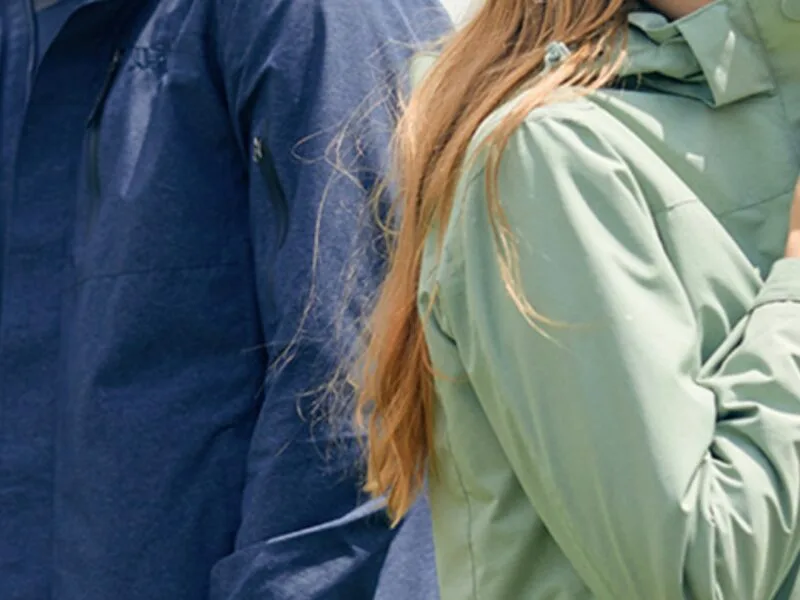
Fabrics for Outdoor Apparel:
Outdoor apparel must endure challenging environments while ensuring the wearer’s comfort, protection, and style. The choice of fabric is critical to achieving these objectives. This article provides an in-depth exploration of the fabrics commonly used in outdoor clothing, highlighting their unique properties, applications, and why they are essential for various outdoor activities.
Key Considerations for Outdoor Apparel Fabrics:Fabrics for Outdoor Apparel
Outdoor fabrics must meet the demands of diverse conditions, from rain and snow to intense sunlight and rugged terrains. The key attributes to consider include:
1.Durability: The ability to resist wear, tear, and abrasions.
2.Water Resistance or Waterproofing: Protection from rain, snow, and moisture.
3.Breathability: Effective moisture management to maintain comfort during physical activity.
4.Insulation: Retaining warmth in cold weather.
5.Lightweight Properties: Minimizing bulk without compromising performance.
Below are the leading fabric options for outdoor apparel and their standout features.
1. Nylon: A Versatile Workhorse
Nylon is widely regarded as a staple for outdoor clothing due to its strength, versatility, and affordability.
•High Durability: Resistant to abrasions and tears, making it ideal for rugged use.
•Lightweight: Maintains comfort without adding bulk.
•Water Resistance: Often treated with Durable Water Repellent (DWR) coatings.
•UV Resistance: Advanced nylon fabrics offer excellent protection against harmful UV rays.
Applications:Fabrics for Outdoor Apparel
Nylon is commonly used in jackets, pants, and backpacks designed for hiking, climbing, and general outdoor activities.
2. Polyester: The All-Rounder
Polyester rivals nylon in outdoor apparel, offering affordability and durability with additional benefits.
Key Features:Fabrics for Outdoor Apparel
•Quick-Drying: Ideal for wet conditions or active pursuits.
•UV Resistance: Naturally more resistant to UV damage than nylon.
•Water Resistance: Can be enhanced with waterproof coatings.
•Low Moisture Absorption: Keeps wearers dry and comfortable.
Applications:Fabrics for Outdoor Apparel
Polyester is a go-to material for base layers, outer shells, and fleece products, making it a favorite in versatile outdoor gear.
3. GORE-TEX: Ultimate Waterproofing and Breathability
GORE-TEX is a premium fabric known for its unparalleled waterproof, windproof, and breathable qualities.
Key Features:Fabrics for Outdoor Apparel
•Waterproof and Windproof: Keeps wearers dry and protected from harsh weather.
•Breathability: Allows sweat vapor to escape, reducing discomfort.
•Durability: Withstands challenging environments over extended periods.
Applications:Fabrics for Outdoor Apparel
Perfect for high-end outdoor jackets, pants, and gloves, especially in extreme conditions like mountaineering or skiing.
4. Softshell Fabrics: Flexible and Breathable
Softshell materials combine comfort, flexibility, and moderate weather protection.
Key Features:Fabrics for Outdoor Apparel
•Stretchability: Enhances mobility, making it ideal for dynamic activities.
•Breathability: Excels in moisture management.
•Water Resistance: Provides sufficient protection against light rain or snow.
Applications:Fabrics for Outdoor Apparel
Popular for jackets and pants used in climbing, hiking, or mild weather conditions.
5. Hard Shell Fabrics: Maximum Weather Protection
Hard shell fabrics are designed to offer full protection against extreme weather while remaining lightweight.
Key Features:
•Waterproof and Windproof: Offers superior protection in storms.
•Lightweight: Does not compromise on comfort.
•Durability: Designed to handle heavy wear and tear.
Applications:
Ideal for outer layers in extreme sports or expeditions, such as snowboarding or ice climbing.
6. Merino Wool: A Natural Wonder
Merino wool is a favorite for outdoor enthusiasts who prioritize natural, sustainable options.
Key Features:
•Thermal Regulation: Keeps wearers warm in cold weather and cool in hot conditions.
•Moisture Wicking: Draws sweat away from the skin, keeping the body dry.
•Odor Resistance: Naturally antibacterial, reducing odor buildup during prolonged use.
Applications:
Merino wool is widely used in base layers, socks, and mid-layers for hiking, skiing, and backpacking.
7. Ripstop Fabrics: Enhanced Durability
Ripstop fabrics incorporate a grid-like structure of reinforced threads, offering exceptional strength.
Key Features:
•Tear Resistance: Prevents rips from spreading, increasing longevity.
•Lightweight: Retains strength without adding unnecessary weight.
•Water Resistance: Often paired with waterproof coatings for enhanced performance.
Applications:
Common in jackets, pants, and tents used for high-stress activities like mountaineering and camping.
8. Fleece: Lightweight Insulation
Fleece is a synthetic fabric designed to provide warmth without bulk.
Key Features:
•Lightweight Insulation: Keeps wearers warm in cooler temperatures.
•Breathability: Prevents overheating during physical activities.
•Quick-Drying: Effective for use in damp environments.
Applications:
Frequently used in mid-layers or standalone garments for hiking, casual wear, or camping.
9. Cotton Blends: A Classic Choice
While pure cotton is not ideal for most outdoor activities, cotton blends can provide comfort and a stylish appearance.
Key Features:
•Softness: Offers natural comfort and breathability.
•Aesthetic Appeal: Adds a casual and traditional look to outdoor gear.
•Limited Water Resistance: Can be treated for moderate moisture protection.
Applications:
Great for casual outdoor wear or light hiking in dry conditions.
10. Recycled Fabrics: Eco-Friendly Alternatives
Sustainability is a growing concern in outdoor apparel, and recycled fabrics offer an excellent solution.
Key Features:
•Environmentally Friendly: Reduces waste and promotes sustainability.
•Performance-Oriented: Modern recycled fabrics match the durability and functionality of virgin materials.
Applications:
Increasingly used in jackets, backpacks, and base layers across eco-conscious brands.
Enhancements for Outdoor Fabrics
Performance of outdoor fabrics can be elevated through treatments and coatings, including:
•Durable Water Repellent (DWR): Improves water resistance.
•UV Protection: Shields wearers from harmful rays.
•Anti-Microbial Treatments: Reduces odor and bacterial growth.
•Windproofing: Enhances protection against cold winds.
Selecting the Best Fabric for Your Needs
Choosing the right fabric depends on the activity and environmental conditions:
•Cold Weather Adventures: Opt for GORE-TEX or fleece for warmth and protection.
•Dynamic Activities: Softshell or stretchable fabrics ensure mobility and breathability.
•Sustainable Choices: Look for recycled polyester or nylon with certifications like GRS.
Conclusion
The fabric used in outdoor apparel can make or break your experience in the great outdoors. From the strength of nylon and polyester to the premium performance of GORE-TEX and the natural benefits of merino wool, each fabric offers unique advantages. By understanding your needs and the fabric options available, you can select the ideal material to keep you comfortable, protected, and ready for any adventure.
Keywords: Outdoor Fabrics, Nylon, Polyester, GORE-TEX, Merino Wool, Softshell, Hard Shell, Ripstop, Recycled Materials, Durable Water Repellent (DWR), Sustainability, Outdoor Apparel.
